Assessing the Impact of Employee Training at Woolworths
VerifiedAdded on 2023/01/20
|10
|1494
|20
Report
AI Summary
This report examines the impact of training and development (T&D) on employee performance, productivity, and job satisfaction within Woolworths. Employing a quantitative research methodology, the study surveyed employees to gather data on the effects of T&D programs. The findings, based on questionnaire responses, indicate that the majority of employees strongly agree that T&D enhances their skills, knowledge, and abilities, leading to improved performance and job satisfaction. The analysis reveals that employees believe T&D programs positively impact Woolworths' development and improve their attitudes. The study also highlights the significance of on-the-job training and the need for Woolworths to continuously adapt its T&D programs to meet employee needs and expectations. The research concludes that T&D is a crucial aspect of HRM, leading to increased employee competence, career development, and overall organizational success.

Business Research 1
BUSINESS RESEARCH
By (Student’s Name)
Professor’s Name
College
Course
Date
BUSINESS RESEARCH
By (Student’s Name)
Professor’s Name
College
Course
Date
Paraphrase This Document
Need a fresh take? Get an instant paraphrase of this document with our AI Paraphraser
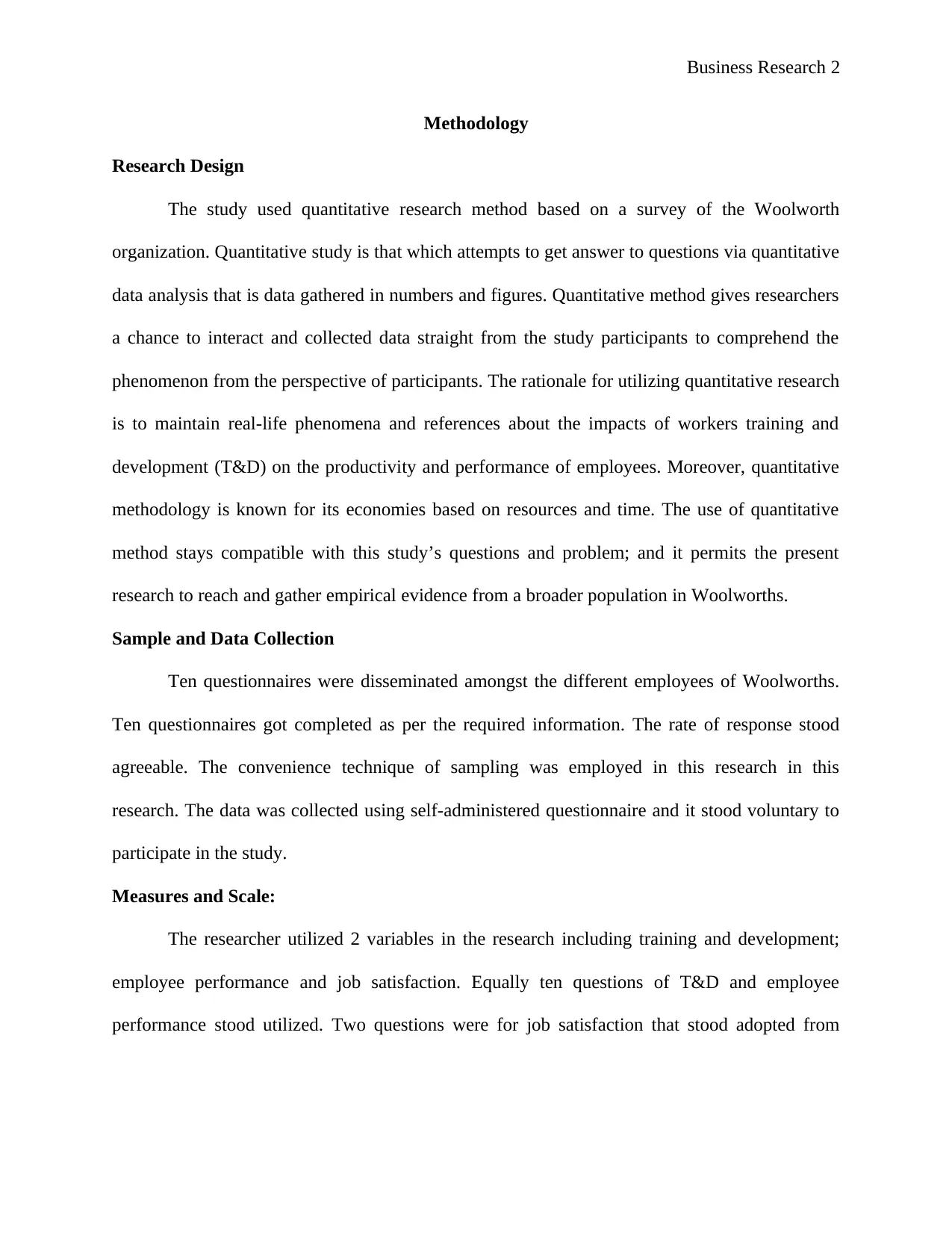
Business Research 2
Methodology
Research Design
The study used quantitative research method based on a survey of the Woolworth
organization. Quantitative study is that which attempts to get answer to questions via quantitative
data analysis that is data gathered in numbers and figures. Quantitative method gives researchers
a chance to interact and collected data straight from the study participants to comprehend the
phenomenon from the perspective of participants. The rationale for utilizing quantitative research
is to maintain real-life phenomena and references about the impacts of workers training and
development (T&D) on the productivity and performance of employees. Moreover, quantitative
methodology is known for its economies based on resources and time. The use of quantitative
method stays compatible with this study’s questions and problem; and it permits the present
research to reach and gather empirical evidence from a broader population in Woolworths.
Sample and Data Collection
Ten questionnaires were disseminated amongst the different employees of Woolworths.
Ten questionnaires got completed as per the required information. The rate of response stood
agreeable. The convenience technique of sampling was employed in this research in this
research. The data was collected using self-administered questionnaire and it stood voluntary to
participate in the study.
Measures and Scale:
The researcher utilized 2 variables in the research including training and development;
employee performance and job satisfaction. Equally ten questions of T&D and employee
performance stood utilized. Two questions were for job satisfaction that stood adopted from
Methodology
Research Design
The study used quantitative research method based on a survey of the Woolworth
organization. Quantitative study is that which attempts to get answer to questions via quantitative
data analysis that is data gathered in numbers and figures. Quantitative method gives researchers
a chance to interact and collected data straight from the study participants to comprehend the
phenomenon from the perspective of participants. The rationale for utilizing quantitative research
is to maintain real-life phenomena and references about the impacts of workers training and
development (T&D) on the productivity and performance of employees. Moreover, quantitative
methodology is known for its economies based on resources and time. The use of quantitative
method stays compatible with this study’s questions and problem; and it permits the present
research to reach and gather empirical evidence from a broader population in Woolworths.
Sample and Data Collection
Ten questionnaires were disseminated amongst the different employees of Woolworths.
Ten questionnaires got completed as per the required information. The rate of response stood
agreeable. The convenience technique of sampling was employed in this research in this
research. The data was collected using self-administered questionnaire and it stood voluntary to
participate in the study.
Measures and Scale:
The researcher utilized 2 variables in the research including training and development;
employee performance and job satisfaction. Equally ten questions of T&D and employee
performance stood utilized. Two questions were for job satisfaction that stood adopted from
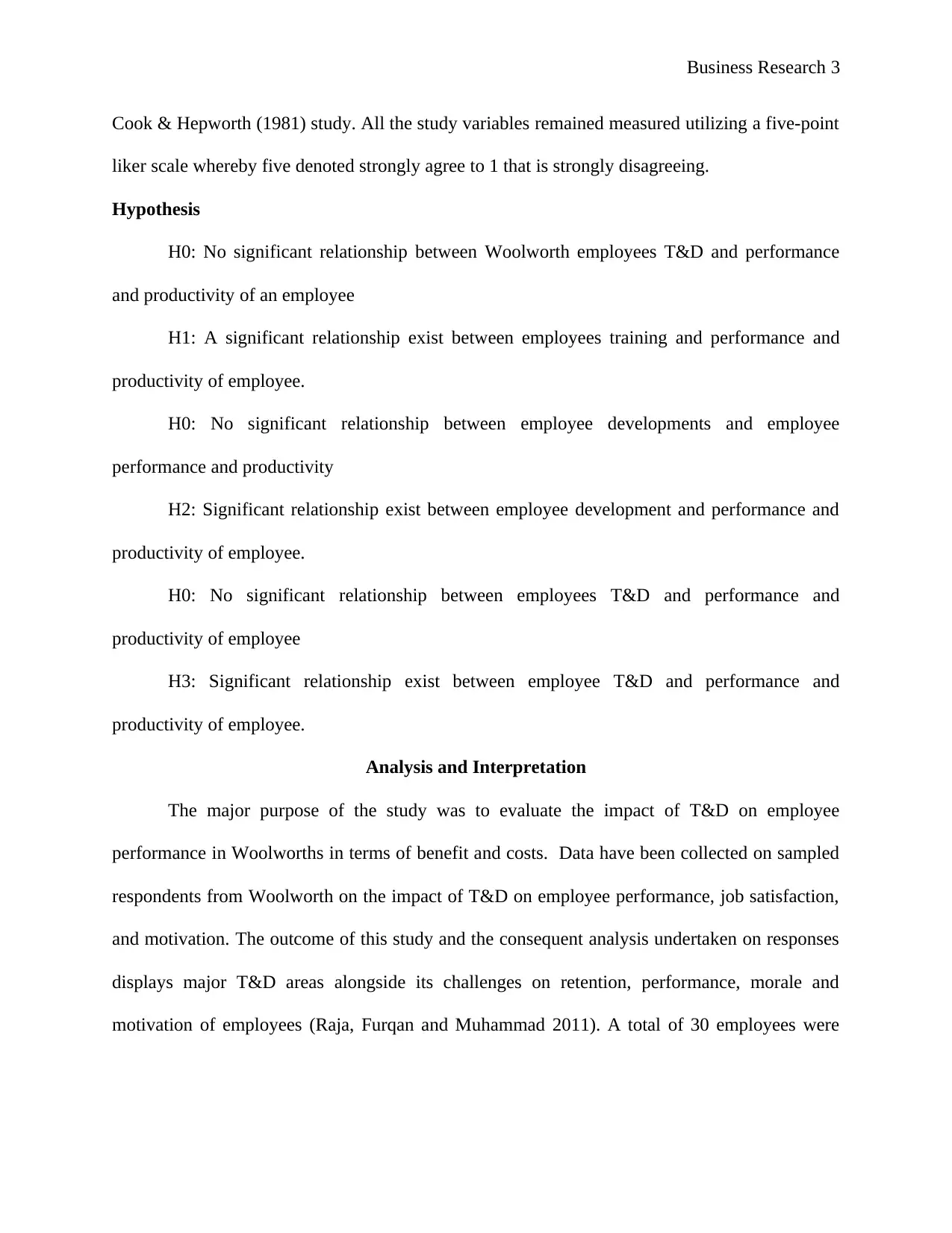
Business Research 3
Cook & Hepworth (1981) study. All the study variables remained measured utilizing a five-point
liker scale whereby five denoted strongly agree to 1 that is strongly disagreeing.
Hypothesis
H0: No significant relationship between Woolworth employees T&D and performance
and productivity of an employee
H1: A significant relationship exist between employees training and performance and
productivity of employee.
H0: No significant relationship between employee developments and employee
performance and productivity
H2: Significant relationship exist between employee development and performance and
productivity of employee.
H0: No significant relationship between employees T&D and performance and
productivity of employee
H3: Significant relationship exist between employee T&D and performance and
productivity of employee.
Analysis and Interpretation
The major purpose of the study was to evaluate the impact of T&D on employee
performance in Woolworths in terms of benefit and costs. Data have been collected on sampled
respondents from Woolworth on the impact of T&D on employee performance, job satisfaction,
and motivation. The outcome of this study and the consequent analysis undertaken on responses
displays major T&D areas alongside its challenges on retention, performance, morale and
motivation of employees (Raja, Furqan and Muhammad 2011). A total of 30 employees were
Cook & Hepworth (1981) study. All the study variables remained measured utilizing a five-point
liker scale whereby five denoted strongly agree to 1 that is strongly disagreeing.
Hypothesis
H0: No significant relationship between Woolworth employees T&D and performance
and productivity of an employee
H1: A significant relationship exist between employees training and performance and
productivity of employee.
H0: No significant relationship between employee developments and employee
performance and productivity
H2: Significant relationship exist between employee development and performance and
productivity of employee.
H0: No significant relationship between employees T&D and performance and
productivity of employee
H3: Significant relationship exist between employee T&D and performance and
productivity of employee.
Analysis and Interpretation
The major purpose of the study was to evaluate the impact of T&D on employee
performance in Woolworths in terms of benefit and costs. Data have been collected on sampled
respondents from Woolworth on the impact of T&D on employee performance, job satisfaction,
and motivation. The outcome of this study and the consequent analysis undertaken on responses
displays major T&D areas alongside its challenges on retention, performance, morale and
motivation of employees (Raja, Furqan and Muhammad 2011). A total of 30 employees were
⊘ This is a preview!⊘
Do you want full access?
Subscribe today to unlock all pages.

Trusted by 1+ million students worldwide
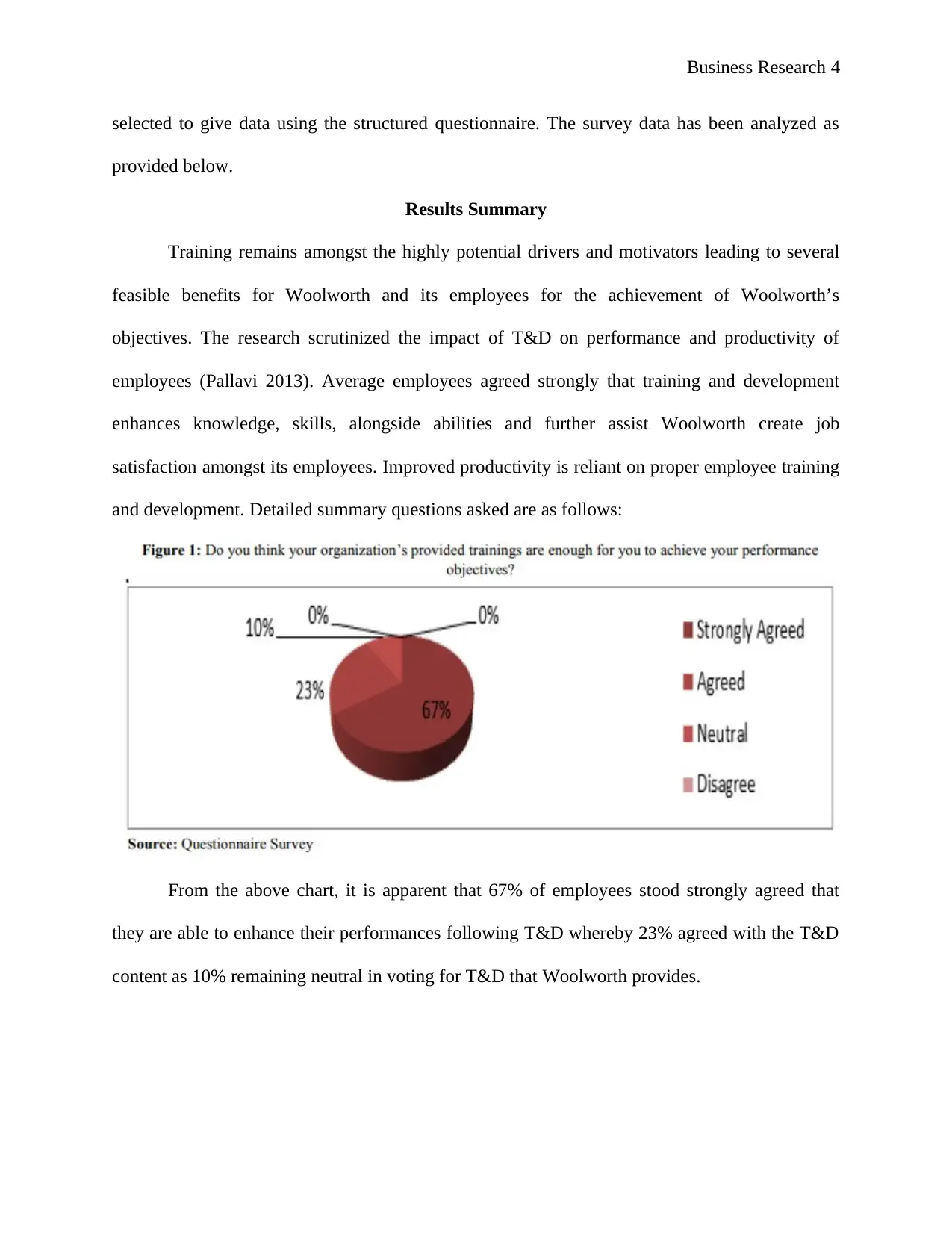
Business Research 4
selected to give data using the structured questionnaire. The survey data has been analyzed as
provided below.
Results Summary
Training remains amongst the highly potential drivers and motivators leading to several
feasible benefits for Woolworth and its employees for the achievement of Woolworth’s
objectives. The research scrutinized the impact of T&D on performance and productivity of
employees (Pallavi 2013). Average employees agreed strongly that training and development
enhances knowledge, skills, alongside abilities and further assist Woolworth create job
satisfaction amongst its employees. Improved productivity is reliant on proper employee training
and development. Detailed summary questions asked are as follows:
From the above chart, it is apparent that 67% of employees stood strongly agreed that
they are able to enhance their performances following T&D whereby 23% agreed with the T&D
content as 10% remaining neutral in voting for T&D that Woolworth provides.
selected to give data using the structured questionnaire. The survey data has been analyzed as
provided below.
Results Summary
Training remains amongst the highly potential drivers and motivators leading to several
feasible benefits for Woolworth and its employees for the achievement of Woolworth’s
objectives. The research scrutinized the impact of T&D on performance and productivity of
employees (Pallavi 2013). Average employees agreed strongly that training and development
enhances knowledge, skills, alongside abilities and further assist Woolworth create job
satisfaction amongst its employees. Improved productivity is reliant on proper employee training
and development. Detailed summary questions asked are as follows:
From the above chart, it is apparent that 67% of employees stood strongly agreed that
they are able to enhance their performances following T&D whereby 23% agreed with the T&D
content as 10% remaining neutral in voting for T&D that Woolworth provides.
Paraphrase This Document
Need a fresh take? Get an instant paraphrase of this document with our AI Paraphraser
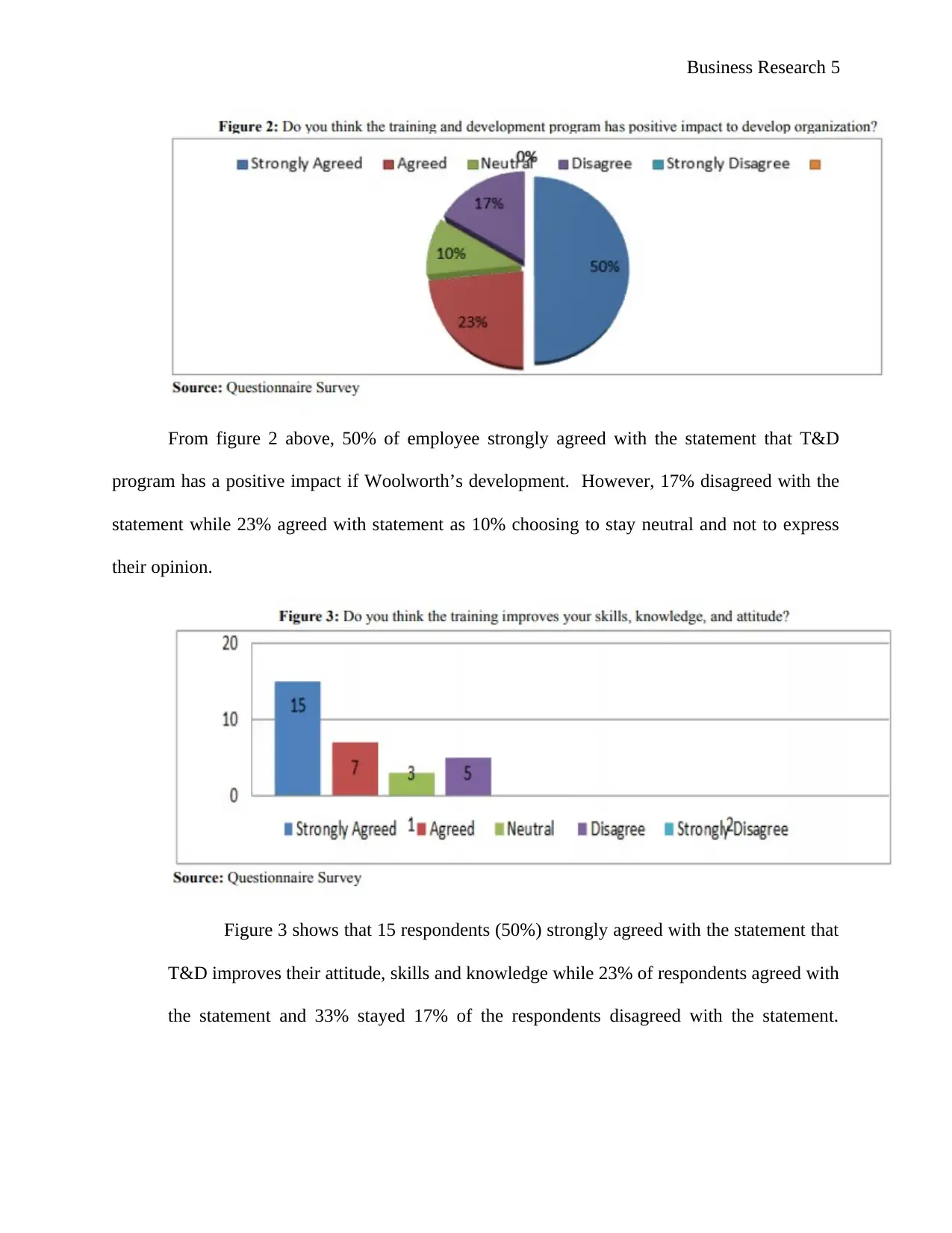
Business Research 5
From figure 2 above, 50% of employee strongly agreed with the statement that T&D
program has a positive impact if Woolworth’s development. However, 17% disagreed with the
statement while 23% agreed with statement as 10% choosing to stay neutral and not to express
their opinion.
Figure 3 shows that 15 respondents (50%) strongly agreed with the statement that
T&D improves their attitude, skills and knowledge while 23% of respondents agreed with
the statement and 33% stayed 17% of the respondents disagreed with the statement.
From figure 2 above, 50% of employee strongly agreed with the statement that T&D
program has a positive impact if Woolworth’s development. However, 17% disagreed with the
statement while 23% agreed with statement as 10% choosing to stay neutral and not to express
their opinion.
Figure 3 shows that 15 respondents (50%) strongly agreed with the statement that
T&D improves their attitude, skills and knowledge while 23% of respondents agreed with
the statement and 33% stayed 17% of the respondents disagreed with the statement.
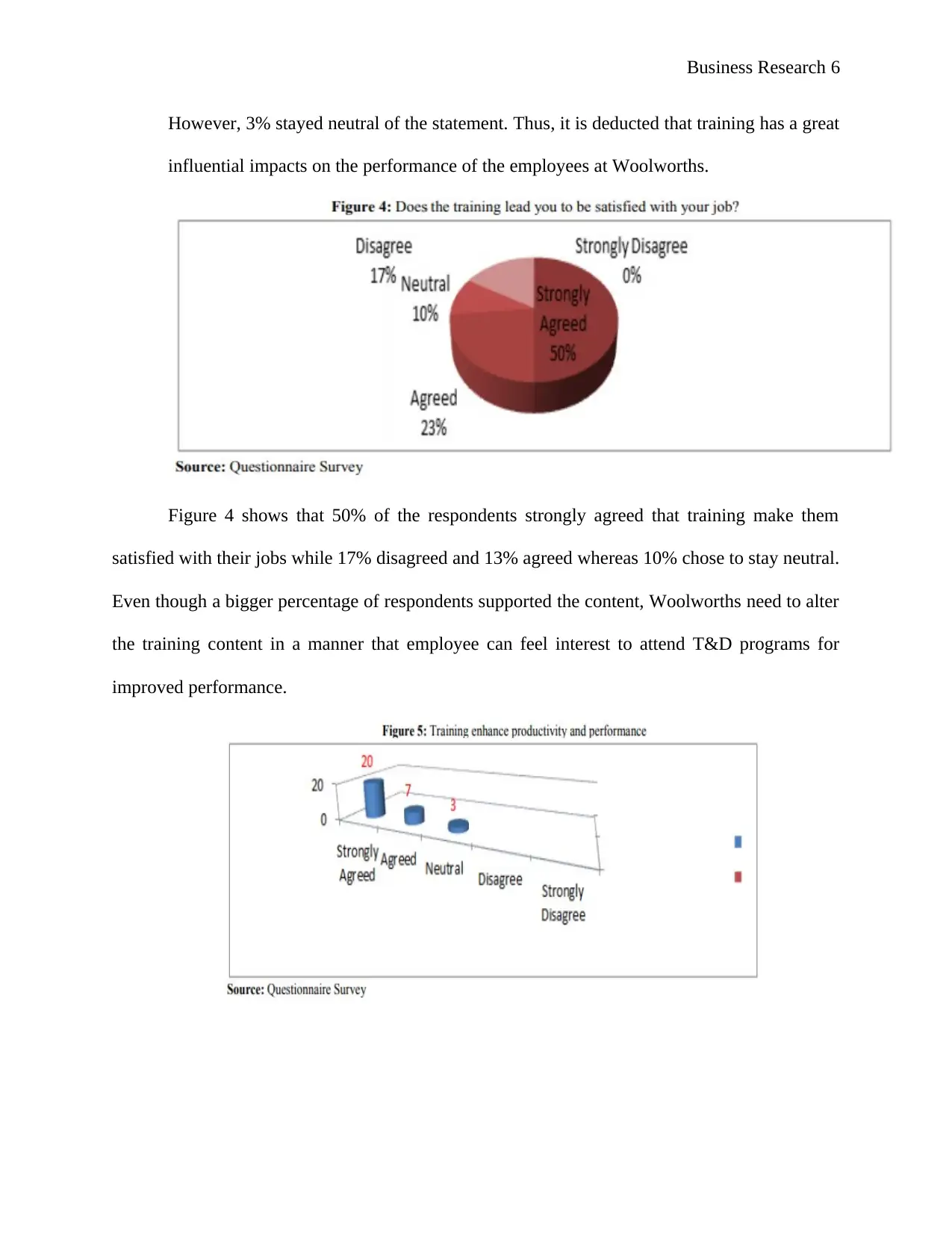
Business Research 6
However, 3% stayed neutral of the statement. Thus, it is deducted that training has a great
influential impacts on the performance of the employees at Woolworths.
Figure 4 shows that 50% of the respondents strongly agreed that training make them
satisfied with their jobs while 17% disagreed and 13% agreed whereas 10% chose to stay neutral.
Even though a bigger percentage of respondents supported the content, Woolworths need to alter
the training content in a manner that employee can feel interest to attend T&D programs for
improved performance.
However, 3% stayed neutral of the statement. Thus, it is deducted that training has a great
influential impacts on the performance of the employees at Woolworths.
Figure 4 shows that 50% of the respondents strongly agreed that training make them
satisfied with their jobs while 17% disagreed and 13% agreed whereas 10% chose to stay neutral.
Even though a bigger percentage of respondents supported the content, Woolworths need to alter
the training content in a manner that employee can feel interest to attend T&D programs for
improved performance.
⊘ This is a preview!⊘
Do you want full access?
Subscribe today to unlock all pages.

Trusted by 1+ million students worldwide
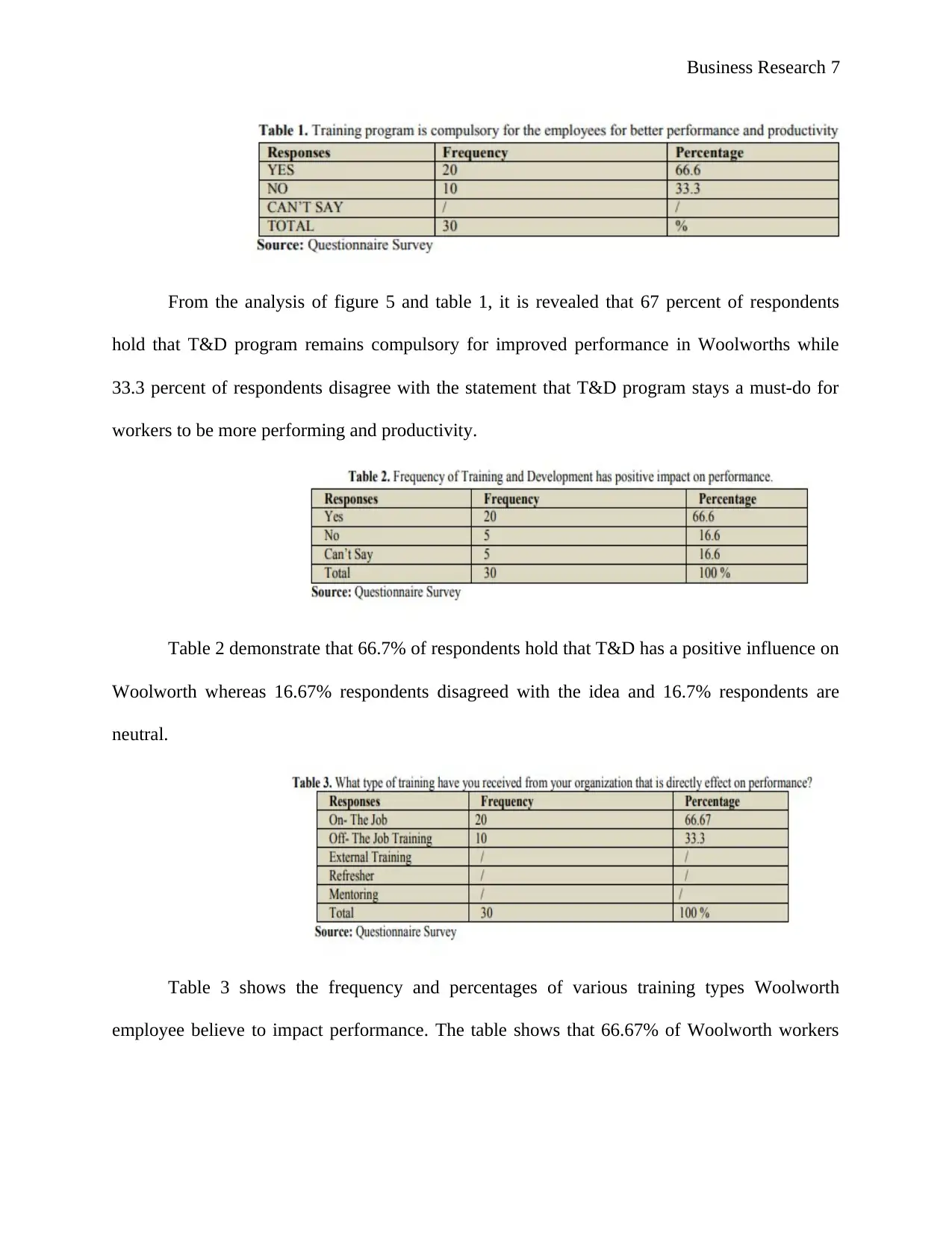
Business Research 7
From the analysis of figure 5 and table 1, it is revealed that 67 percent of respondents
hold that T&D program remains compulsory for improved performance in Woolworths while
33.3 percent of respondents disagree with the statement that T&D program stays a must-do for
workers to be more performing and productivity.
Table 2 demonstrate that 66.7% of respondents hold that T&D has a positive influence on
Woolworth whereas 16.67% respondents disagreed with the idea and 16.7% respondents are
neutral.
Table 3 shows the frequency and percentages of various training types Woolworth
employee believe to impact performance. The table shows that 66.67% of Woolworth workers
From the analysis of figure 5 and table 1, it is revealed that 67 percent of respondents
hold that T&D program remains compulsory for improved performance in Woolworths while
33.3 percent of respondents disagree with the statement that T&D program stays a must-do for
workers to be more performing and productivity.
Table 2 demonstrate that 66.7% of respondents hold that T&D has a positive influence on
Woolworth whereas 16.67% respondents disagreed with the idea and 16.7% respondents are
neutral.
Table 3 shows the frequency and percentages of various training types Woolworth
employee believe to impact performance. The table shows that 66.67% of Woolworth workers
Paraphrase This Document
Need a fresh take? Get an instant paraphrase of this document with our AI Paraphraser
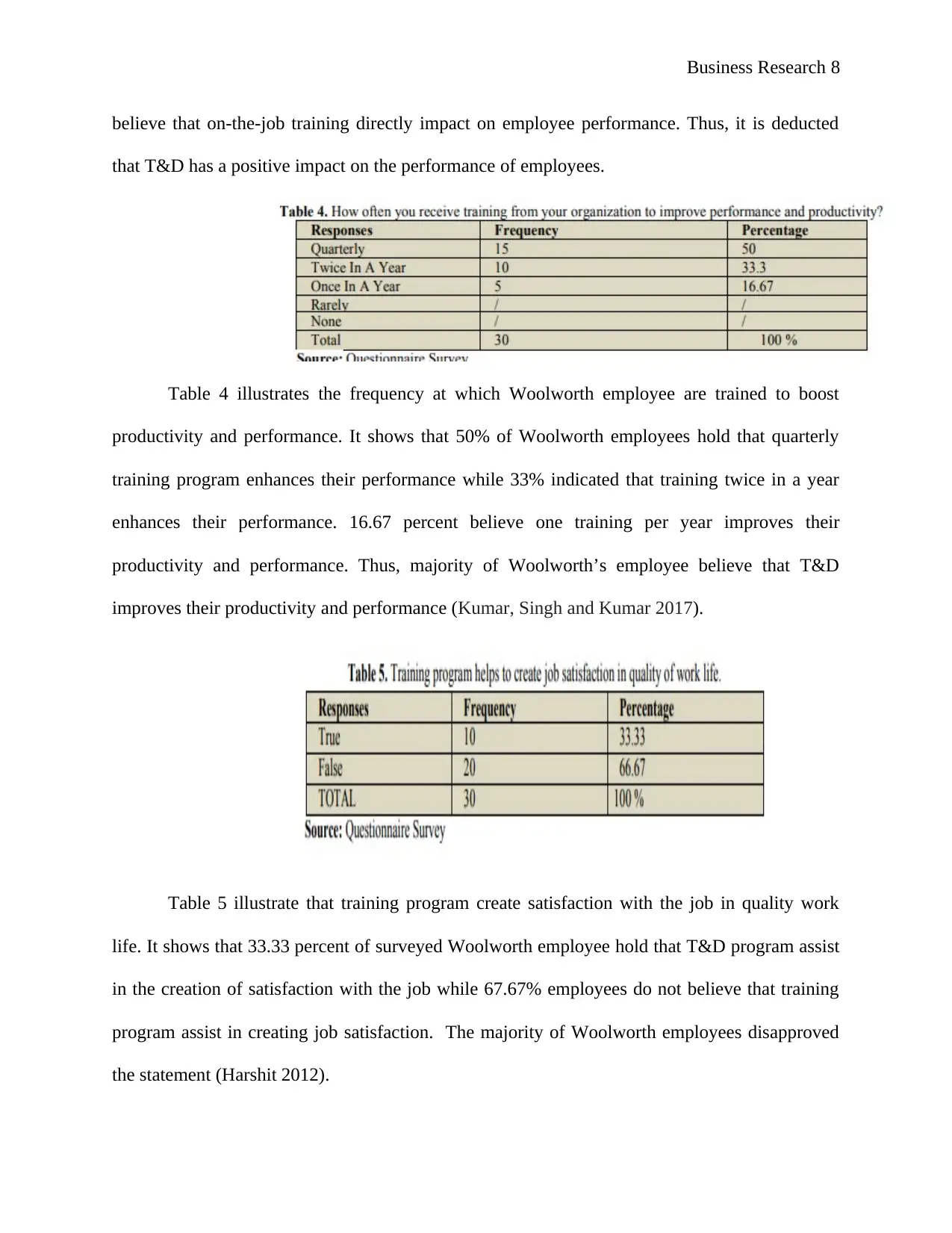
Business Research 8
believe that on-the-job training directly impact on employee performance. Thus, it is deducted
that T&D has a positive impact on the performance of employees.
Table 4 illustrates the frequency at which Woolworth employee are trained to boost
productivity and performance. It shows that 50% of Woolworth employees hold that quarterly
training program enhances their performance while 33% indicated that training twice in a year
enhances their performance. 16.67 percent believe one training per year improves their
productivity and performance. Thus, majority of Woolworth’s employee believe that T&D
improves their productivity and performance (Kumar, Singh and Kumar 2017).
Table 5 illustrate that training program create satisfaction with the job in quality work
life. It shows that 33.33 percent of surveyed Woolworth employee hold that T&D program assist
in the creation of satisfaction with the job while 67.67% employees do not believe that training
program assist in creating job satisfaction. The majority of Woolworth employees disapproved
the statement (Harshit 2012).
believe that on-the-job training directly impact on employee performance. Thus, it is deducted
that T&D has a positive impact on the performance of employees.
Table 4 illustrates the frequency at which Woolworth employee are trained to boost
productivity and performance. It shows that 50% of Woolworth employees hold that quarterly
training program enhances their performance while 33% indicated that training twice in a year
enhances their performance. 16.67 percent believe one training per year improves their
productivity and performance. Thus, majority of Woolworth’s employee believe that T&D
improves their productivity and performance (Kumar, Singh and Kumar 2017).
Table 5 illustrate that training program create satisfaction with the job in quality work
life. It shows that 33.33 percent of surveyed Woolworth employee hold that T&D program assist
in the creation of satisfaction with the job while 67.67% employees do not believe that training
program assist in creating job satisfaction. The majority of Woolworth employees disapproved
the statement (Harshit 2012).
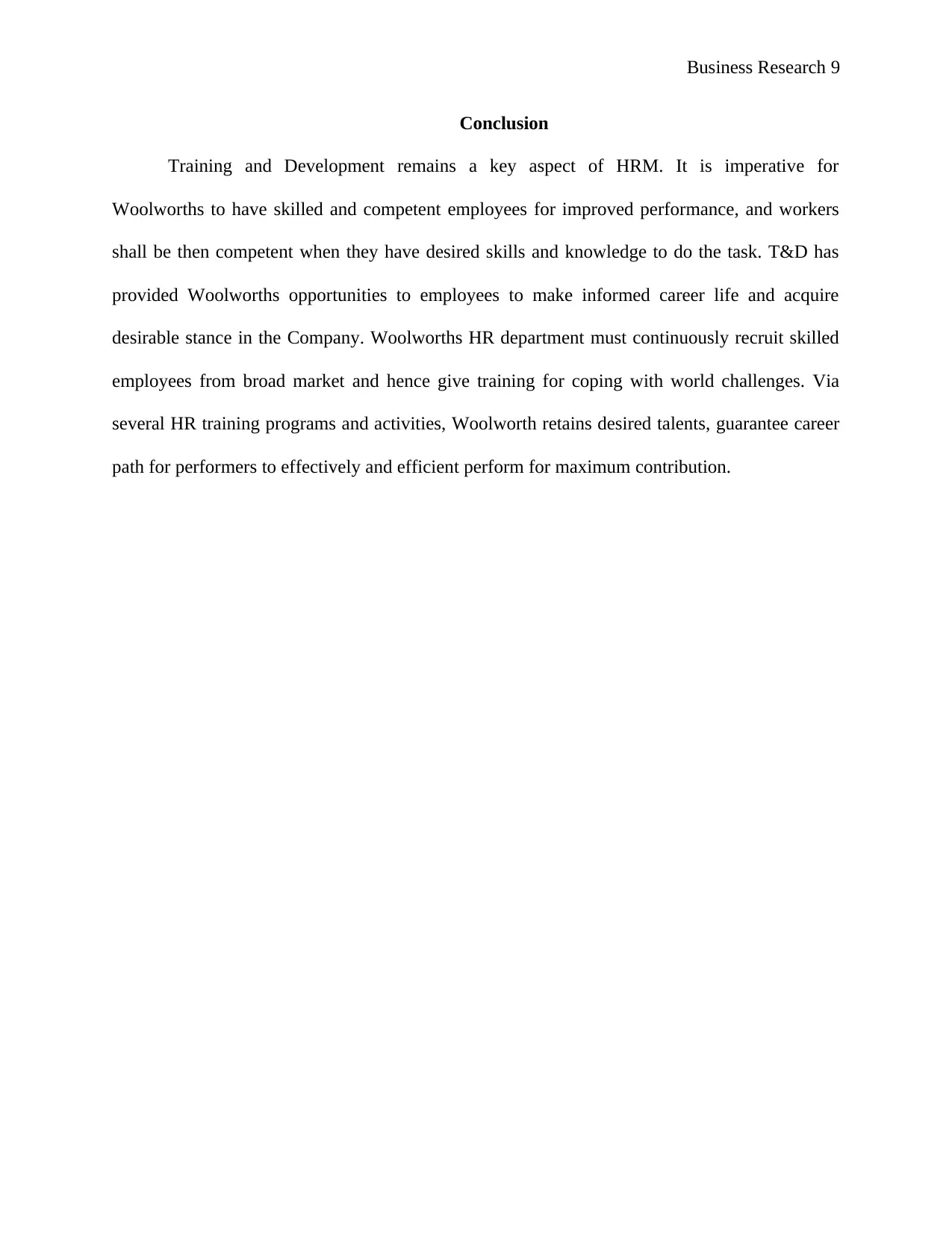
Business Research 9
Conclusion
Training and Development remains a key aspect of HRM. It is imperative for
Woolworths to have skilled and competent employees for improved performance, and workers
shall be then competent when they have desired skills and knowledge to do the task. T&D has
provided Woolworths opportunities to employees to make informed career life and acquire
desirable stance in the Company. Woolworths HR department must continuously recruit skilled
employees from broad market and hence give training for coping with world challenges. Via
several HR training programs and activities, Woolworth retains desired talents, guarantee career
path for performers to effectively and efficient perform for maximum contribution.
Conclusion
Training and Development remains a key aspect of HRM. It is imperative for
Woolworths to have skilled and competent employees for improved performance, and workers
shall be then competent when they have desired skills and knowledge to do the task. T&D has
provided Woolworths opportunities to employees to make informed career life and acquire
desirable stance in the Company. Woolworths HR department must continuously recruit skilled
employees from broad market and hence give training for coping with world challenges. Via
several HR training programs and activities, Woolworth retains desired talents, guarantee career
path for performers to effectively and efficient perform for maximum contribution.
⊘ This is a preview!⊘
Do you want full access?
Subscribe today to unlock all pages.

Trusted by 1+ million students worldwide
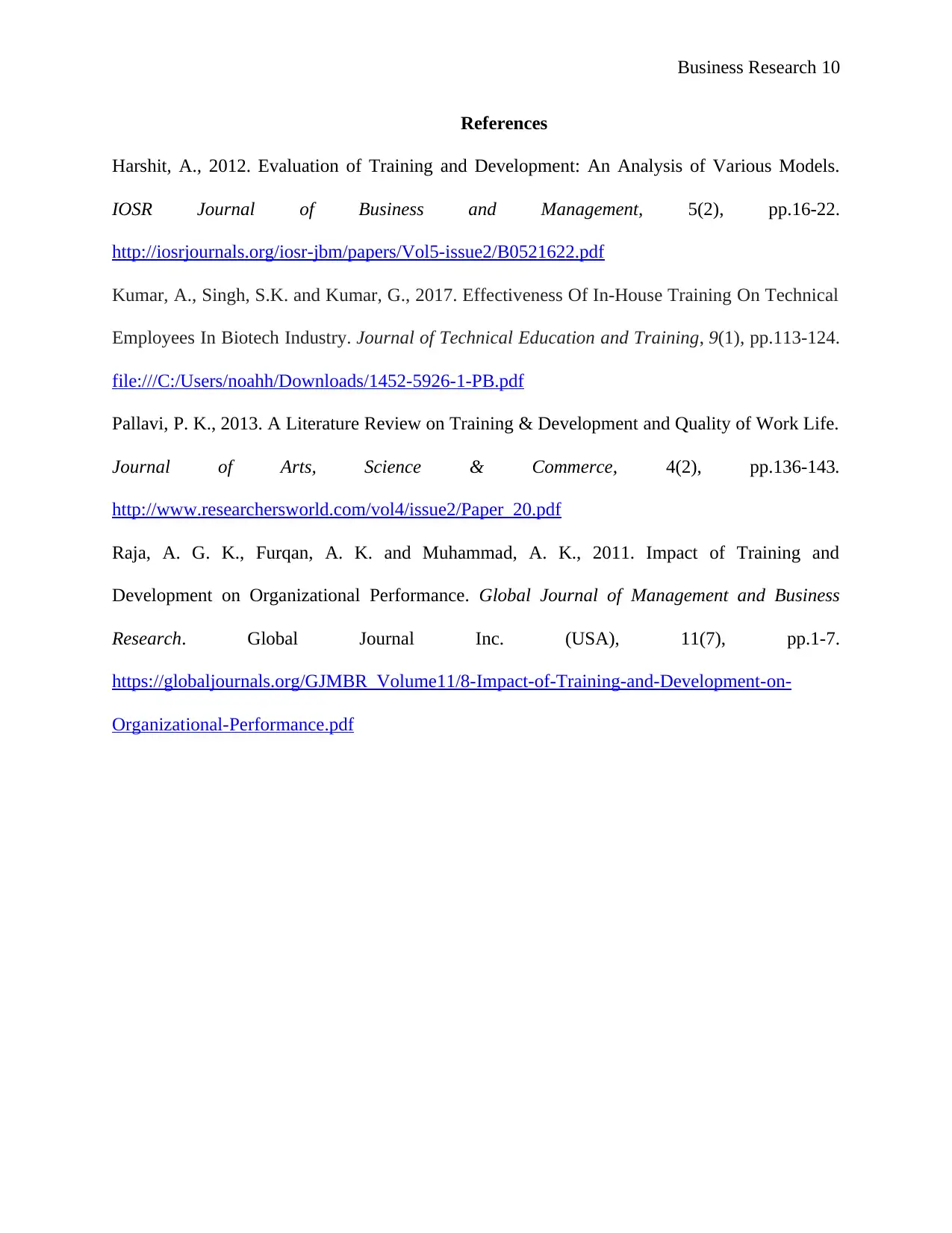
Business Research 10
References
Harshit, A., 2012. Evaluation of Training and Development: An Analysis of Various Models.
IOSR Journal of Business and Management, 5(2), pp.16-22.
http://iosrjournals.org/iosr-jbm/papers/Vol5-issue2/B0521622.pdf
Kumar, A., Singh, S.K. and Kumar, G., 2017. Effectiveness Of In-House Training On Technical
Employees In Biotech Industry. Journal of Technical Education and Training, 9(1), pp.113-124.
file:///C:/Users/noahh/Downloads/1452-5926-1-PB.pdf
Pallavi, P. K., 2013. A Literature Review on Training & Development and Quality of Work Life.
Journal of Arts, Science & Commerce, 4(2), pp.136-143.
http://www.researchersworld.com/vol4/issue2/Paper_20.pdf
Raja, A. G. K., Furqan, A. K. and Muhammad, A. K., 2011. Impact of Training and
Development on Organizational Performance. Global Journal of Management and Business
Research. Global Journal Inc. (USA), 11(7), pp.1-7.
https://globaljournals.org/GJMBR_Volume11/8-Impact-of-Training-and-Development-on-
Organizational-Performance.pdf
References
Harshit, A., 2012. Evaluation of Training and Development: An Analysis of Various Models.
IOSR Journal of Business and Management, 5(2), pp.16-22.
http://iosrjournals.org/iosr-jbm/papers/Vol5-issue2/B0521622.pdf
Kumar, A., Singh, S.K. and Kumar, G., 2017. Effectiveness Of In-House Training On Technical
Employees In Biotech Industry. Journal of Technical Education and Training, 9(1), pp.113-124.
file:///C:/Users/noahh/Downloads/1452-5926-1-PB.pdf
Pallavi, P. K., 2013. A Literature Review on Training & Development and Quality of Work Life.
Journal of Arts, Science & Commerce, 4(2), pp.136-143.
http://www.researchersworld.com/vol4/issue2/Paper_20.pdf
Raja, A. G. K., Furqan, A. K. and Muhammad, A. K., 2011. Impact of Training and
Development on Organizational Performance. Global Journal of Management and Business
Research. Global Journal Inc. (USA), 11(7), pp.1-7.
https://globaljournals.org/GJMBR_Volume11/8-Impact-of-Training-and-Development-on-
Organizational-Performance.pdf
1 out of 10
Related Documents
Your All-in-One AI-Powered Toolkit for Academic Success.
+13062052269
info@desklib.com
Available 24*7 on WhatsApp / Email
![[object Object]](/_next/static/media/star-bottom.7253800d.svg)
Unlock your academic potential
Copyright © 2020–2025 A2Z Services. All Rights Reserved. Developed and managed by ZUCOL.





